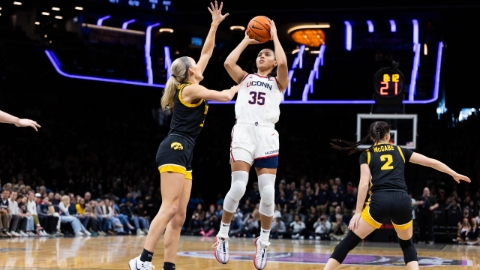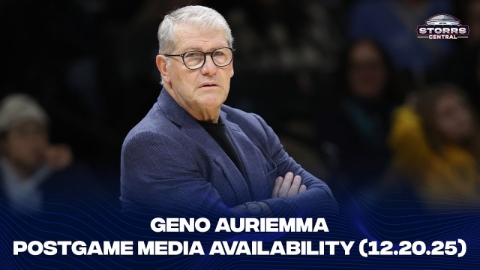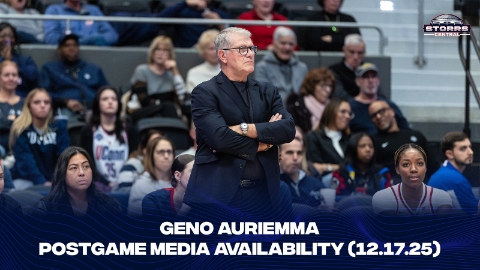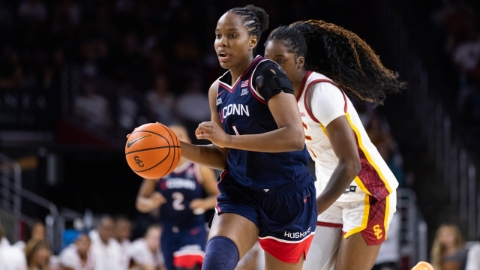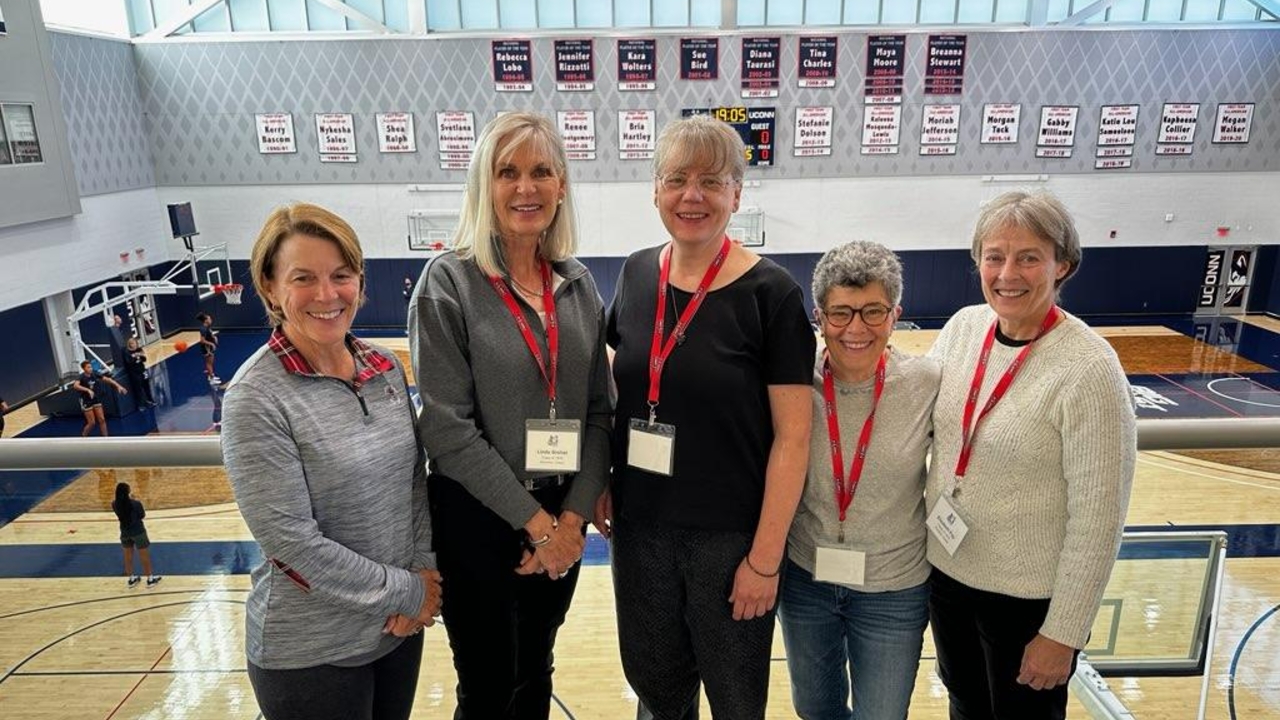
On June 23, 1972, President Richard Nixon signed into law a series of amendments to the Higher Education Act of 1965. The most famous of these is Title IX, which banned sex-based discrimination in school activities that received federal financial assistance. The upshot of this was a slow but steady remaking of college sports, leading to more opportunities for women to participate in varsity athletics.
At the University of Connecticut, these new mandates led to the creation of a cluster of new varsity programs, including UConn women’s basketball, which stands today as one of the greatest dynasties in the sporting world.
Before the banners, before Gampel Pavilion, before Geno, Sandra Hamm drove from Manchester to Storrs after her day job as a teacher to coach the first varsity women’s basketball team at UConn.
Here’s the story of the first-ever UConn women’s basketball team.
Early Days
Fifty years ago this fall, the first UConn women’s varsity basketball team took to the floor under the leadership of Sandra Hamm, a newly-minted physical education teacher.
The 1974-1975 women’s team received little press coverage. None of the players had athletic scholarships. Their resources and access to the amenities of the athletic department were minimal. Games held at either the Fieldhouse or Guyer Gym drew friends and family.
They won just two games but they were pioneers who played a significant role in making UConn an epicenter of women’s college sports, even if they didn’t know it at the time.
“I don’t know that anybody thought about the significance of it. They didn’t make a big deal about it,” said Linda Staveski Groher, who played varsity basketball from 1974 until 1977.
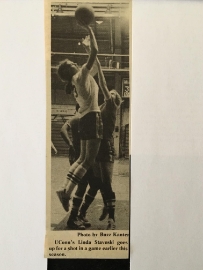
“We didn’t know we were the first varsity team,” said Groher’s classmate Meryl Davis McKenna, who played two seasons of varsity basketball (1974-1976).
Frequently, McKenna hosted her good friend Groher in her dorm freshman year. Groher commuted to campus from Woodstock and stayed over to avoid the drive home after a tiring night of practice.
“I tried out as a freshman and there were upperclassmen in our tryouts, and I just assumed I was joining ‘the team,’” McKenna said. It was not until attending a fiftieth anniversary commemoration of Title IX at UConn in October 2022 when McKenna learned that the 1974-1975 squad was the first varsity women’s team in school history.
The 1974-1975 season was far from the first time that women’s basketball was played in Storrs. The UConn physical education department started an intramural women’s basketball program during the early 1960s. Eventually, women’s basketball at UConn evolved into a club team that played against other Connecticut schools.
Until 1971, women’s games were six-on-six contests in which three players stayed on the offensive end and three remained on the defensive end. Initially, players could only dribble three times before they had to pass the ball. The condescension built into the rules of the women’s game irked many players, who wanted the game to be a genuinely athletic and competitive enterprise.
After 1971, women’s basketball became a full-court, five-on-five affair, signaling the emergence of the modern version of the game.
Karen Robbins, co-captain of the first UConn women’s varsity team, experienced the rule changes during her time in Storrs. She was a senior in 1974-1975, having played club and intramural basketball during her first three years. During her sophomore season, UConn switched from six-on-six women’s basketball to five-on-five.
“With the rule changes in the years before I came, it got to be a real game. Before it was, ‘oh, they can’t run that far. They’re going to be too tired or it will hurt them,” Robbins said.
“We played at Hawley Armory,” Robbins remembered of the club team. “There was room for one row of seats behind us and the pool was underneath. We played there until they finally decided that we could move into the Fieldhouse during my senior year.”
In late 1973, UConn’s athletic department announced plans to start varsity basketball for the 1974-1975 season. They hired a young, enthusiastic, and knowledgeable first head coach in Sandra Hamm.
“I came from a family that was very outdoorsy and very athletic. All of my siblings have played and coached in numerous capacities,” Hamm said. She grew up in Terryville, encouraged by her mom and dad to try a range of sports, including skiing. During her adolescence, Hamm founded the Terryville Ski Club, an organization still in existence. Basketball was always near the forefront of her family’s athletic interests.
“My Dad was a builder and he had a basketball hoop set up with a light so that we could all go out there and play with our neighborhood friends,” Hamm said. Sandra and her sister Linda played organized basketball in high school for the first time. Terryville High School competed against other institutions in Litchfield County. Linda, too, became a college head coach. She spent two seasons leading the women’s program at the University of New Haven (1980-1982). Sandra served as her assistant.
Hamm attended Central Connecticut State University, where she played basketball and studied physical education. She regards the school’s longtime women’s basketball coach Brenda Reilly as one of her primary mentors. Hamm graduated with Central Connecticut’s first physical education class in 1973 and got a job teaching at Bennett Junior High School in Manchester. Her strong basketball and physical education background made her an ideal candidate for helping UConn transition its women’s team from its club and intramural roots to intercollegiate competition in the Association for Intercollegiate Athletics for Women (AIAW), the governing body for college women’s sports before the NCAA started holding women’s national tournaments in the early 1980s.
“I was approached and asked if I would like to come in and be the interim coach for the season,” Hamm said. “They really wanted someone who had a masters who could teach and coach at the same time and I didn’t,” leading to her interim status as coach. During the 1974-1975 season, Hamm drove straight from school to Storrs to hold practice.
“I liked Sandy. I thought she was very nice. She worked with us and helped us the best that she could,” Groher said.
“She was young and she seemed very knowledgeable,” McKenna said. “We didn’t know much about her but we learned a lot about the game.”
“She helped us become a team. I give her credit for doing that with nothing. I was a starting forward and I was 5’7,” Robbins said.
“The young ladies that played were there because they loved the sport. They played hard and they practiced hard,” Hamm said. “There was no expectation on my part as far as wins and losses.”
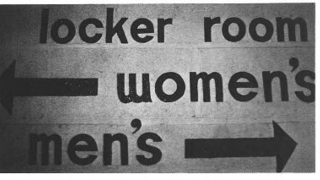
Nor were their expectations great in terms of amenities. The team had 60 to 90 minutes of floor time in the best of circumstances and had to fit practices and games around other team’s schedules. Usually, they played at Guyer Gym but got to play some games at the Fieldhouse. At the Fieldhouse, the team used the visitors’ locker room, which they shared with the field hockey team.
Guyer Gym was famous for its leaky roof, seams in the courts, and ubiquitous buckets to catch the rainwater.
“In that time, it was great what we had. We were last on the list, but I understood it at the time. It was at the time when things were starting to change ever so slowly for women,” Hamm said. She appreciated the hands-off approach the athletic department took toward the program, giving her time to coach the team without anyone looming over her shoulder.
“Early in the season, coach made us run a mile at the Fieldhouse. There was a track painted on the floor. We were not that fit for running a mile. We could do it but the next day, we were not very good,” McKenna recalls.
“There were no lockers or anything at Hawley Armory. When we moved into the Field House, we got to play but we didn’t have any extra facilities. There were no workout rooms. We’d get up in the morning and jog around the campus and people would look at you like ‘what’s this person doing?’” Robbins said, noting that she was happy simply to have the opportunity to play competitive basketball on a real court.
“I was very fortunate in my timing. Growing up, there were no parks and rec girls teams. We were grateful to be able to have coaches and uniforms and have state-run vehicles that would take us places,” McKenna said.
“At Guyer Gym, they had a curtain around our court with the track runners going around it. It seemed like they were trying to accommodate everyone,” Groher recalled.
Many of the women on UConn’s first women’s team played multiple varsity sports.
Armeter (now Armada) Pinkins played five varsity sports at UConn: field hockey, volleyball, basketball, softball, and bowling. “I’d bowled in leagues since I was a child. On the UConn bowling team, I went to the nationals and was ranked twelfth in the nation at one time.”
Pinkins grew up in Harlem and excelled as a student and an athlete. She attended Walton High School in the Bronx where she played on their powerhouse girls basketball team. She played club basketball at UConn before making the Huskies' first varsity team in 1974-1975.
Pinkins was the first in her family to attend college, joining UConn’s ROTC program. She spent a decade in the Air Force, working for a time on the Titan II missile crew. She then worked for years as a teacher in several American cities before becoming a missionary and teaching at a school she founded in Jamaica.
“In today’s world, the lady Huskies are praised and celebrated. We were tolerated,” Pinkins said of her experience playing basketball at UConn.
Meryl Davis McKenna grew up playing all kinds of sports with her two older brothers. She played basketball and tennis in high school. When she got to UConn, fliers advertising tryouts for the varsity teams in both sports caught her eye. Karen Robbins had a similar experience.
“I had a brother who was a year younger and we played a lot of baseball. In high school, we only had softball and basketball so I played them. Going into UConn, I was interested in continuing and I played both,” Robbins said.
There were no scholarships to be had. The athletic department put up fliers around campus for women’s basketball tryouts, operating in the same way they did when the sport had club or intramural status.
First Scholarships
Karen Mullins, who played softball and women’s basketball for the Huskies from 1975 until 1978, became the first woman in UConn history to receive an athletic scholarship. Athletic director John Toner offered Mullins a scholarship that opened up on the football team in the summer of 1976—a strikingly progressive move at the time. The scholarship enabled Mullins to spend the summer recovering from knee surgery rather than working a full-time job to pay for her education.
Mullins went on to spend 31 seasons (1984-2014) as UConn’s softball coach, becoming one of the greatest coaches in the history of the sport. Her Huskies won more than 850 games, seven Big East titles, made eight NCAA Tournament appearances, and reached the 1993 College World Series. Several years after Mullins, Chris Gedney became the first female athlete at UConn to receive a full scholarship for basketball.
On December 5, 1974, the Huskies defeated Eastern Connecticut 40-27 in the first varsity women’s basketball game in UConn history. UConn then defeated Keene State 39-36 in their second game before struggling for the remainder of the schedule.
The Huskies roster was simply less experienced than most of the opposition, as UConn finished the 1974-1975 campaign with a 2-8 record. Nevertheless, the likes of Robbins, Linda Staveski Groher, Meryl Davis McKenna, Susan Fellows, and Carla Massaro made significant contributions on the floor for the Huskies.
“I remember being hard on myself after losses. One time, we played a really good team and had worked really hard but we just didn’t have the talent to beat them,” McKenna said.
UConn’s opposition consisted exclusively of schools from New England and New York State. Despite the team’s struggles on the scoreboard, road trips deepened connections.
“There was the camaraderie of the team and being able to go to different places to play. One of them I remember is going to Burlington, Vermont. The other team (The University of Vermont) said ‘Hey, we can put people up in our room.’ And we brought our sleeping bags and slept on the floor of the other team and got to get to know the other team a little bit. It was fun for us because it was something different and we got to learn from other teams and play some basketball,” Robbins said.
“We took a school bus I think to most games,” McKenna said. “We were a very tight team. We enjoyed the bus rides. I think it made us more of a group. If you were practicing and you were on the first team, you spent a lot of time with them. If you were on the second team, you spent a lot of time with them. Same thing if you were on JV. When you got on the bus, you all went on the bus together and I think it made us a much tighter group of friends.”
Crowds at home games consisted of family and friends. Rarely did more than 100 people attend.
“My parents lived close by and came to all the games but there weren’t that many fans at the games,” Groher said.
“The stands were pretty much just our families if they could commute to come watch a game. There wasn’t much of a student presence at all,” Robbins said.
On at least two occasions, the women’s team had the opportunity to play in front of the largest possible contingent of Husky basketball fans.
“We were the halftime entertainment for a couple of men’s games,” McKenna said. Ten-minute intersquad scrimmages by the women’s team were presented as halftime curiosities. One of the scrimmages was broadcast as part of local TV coverage of Huskies men’s basketball, making it one of the earliest appearances of women’s basketball on a Connecticut station.
“One of the gals, I don’t remember whom, wowed the crowd by hitting a couple of pretty deep shots,” McKenna said.
Sandra Hamm completed her season as interim head coach with a great sense of pride in what the team had accomplished and appreciation for the opportunity she had been afforded.
“The girls that came, they worked hard. With what we had, we did the best we could,” Hamm said. “At the end of a season, they asked me to do an evaluation and I suggested that if they wanted to really make the program viable and competitive, they needed to offer the women a little more than what we had. Whether that’s time to practice in the gym or work out with weights.”
After her tenure at UConn, Hamm continued teaching junior high school before going to work for her father’s building company. She later relocated to Vermont.
To replace Hamm, John Toner hired Wanda Flora, who had been the head coach at Wilson College in Pennsylvania. Flora taught physical education and served as an assistant field hockey coach while leading the basketball program.
According to published accounts, Flora clashed with several of her players over the direction of the program. Many of the players wanted the team to push to be more competitive while Flora, apparently, saw the basketball program as an opportunity for students to participate, a sensibility keeping with her role as a physical education instructor.
In 1980, Jean Balthaser took over from Flora but the program continued to struggle during her five seasons, which included the team’s transition from the AIAW to the NCAA and the Big East Conference.
“They hired Wanda Flora, who was a combination teacher and coach. They really needed to go on with just a coach. The men have a coach, not a coach and a teacher,” Hamm said, appreciating the difficult spot Flora faced trying to juggle the roles.
“At the time, I assumed that Wanda had more experience but I wasn’t quite sure why Coach Hamm didn’t have the job anymore. I thought Wanda brought in a little more expertise for the forwards and centers, which I appreciated as a guard,” said McKenna, who served as a captain as a sophomore before concentrating on tennis in her final two years.
Foundation Built
After finishing at UConn, McKenna moved to California and worked for IBM, losing touch with what was happening with the basketball program. When she moved back to the East Coast in the late 1980s, she started catching wind of the success the Geno Auriemma-led program was having in Storrs.
In the 11 seasons of UConn women’s basketball before the 1985 arrival of Geno Auriemma, the program won just 92 games and posted one winning season.
That all changed under Auriemma, who transformed the Huskies into a national program by the decade’s end.
By the century’s end, they were the gold standard of college basketball. Auriemma’s arrival, too, signaled a new commitment to the program, one in keeping with new University president John Casteen’s commitment to building competitive athletic programs in Storrs. Women’s athletics would soon have more scholarships at their disposal, better housing and amenities, as well as access to improved training facilities and nutrition.
When members of the original UConn women’s varsity team return to Storrs, as several did during the recent Title IX 50th anniversary and reunion, they express a sense of pride in the pioneering role they played in sports history, even if they didn’t think of it in those terms at the time.
“When we go back to Storrs, you feel it. They used to have alumni games and they were so much fun to get back there and get together with everyone. Seeing people I’d known and getting introduced to some of the up-and-coming players,” said Linda Staveski Groher.
“Last year, when they had the Title IX celebration, I was amazed at how far girls’ sports at UConn had come. At first, I didn’t know if I would know anybody but as I was signing up at the Fieldhouse, three or four people said ‘Linda, Linda.’ It was so awesome to take pictures and talk and watch the practice.”
“When I found out we were the first, it was an honor to have been part of that to take advantage of it and experience it,” McKenna said. “I’m especially glad how it’s taken off and what it’s meant to my daughter’s daughter and the opportunities that she’ll have as a result.”
